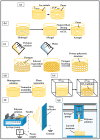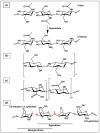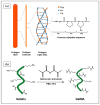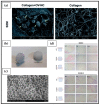Polymeric Hydrogels for In Vitro 3D Ovarian Cancer Modeling
- PMID: 35328686
- PMCID: PMC8954571
- DOI: 10.3390/ijms23063265
Polymeric Hydrogels for In Vitro 3D Ovarian Cancer Modeling
Abstract
Ovarian cancer (OC) grows and interacts constantly with a complex microenvironment, in which immune cells, fibroblasts, blood vessels, signal molecules and the extracellular matrix (ECM) coexist. This heterogeneous environment provides structural and biochemical support to the surrounding cells and undergoes constant and dynamic remodeling that actively promotes tumor initiation, progression, and metastasis. Despite the fact that traditional 2D cell culture systems have led to relevant medical advances in cancer research, 3D cell culture models could open new possibilities for the development of an in vitro tumor microenvironment more closely reproducing that observed in vivo. The implementation of materials science and technology into cancer research has enabled significant progress in the study of cancer progression and drug screening, through the development of polymeric scaffold-based 3D models closely recapitulating the physiopathological features of native tumor tissue. This article provides an overview of state-of-the-art in vitro tumor models with a particular focus on 3D OC cell culture in pre-clinical studies. The most representative OC models described in the literature are presented with a focus on hydrogel-based scaffolds, which guarantee soft tissue-like physical properties as well as a suitable 3D microenvironment for cell growth. Hydrogel-forming polymers of either natural or synthetic origin investigated in this context are described by highlighting their source of extraction, physical-chemical properties, and application for 3D ovarian cancer cell culture.
Keywords: 3D cell culture; hydrogel; ovarian cancer; polymer; scaffold.
Conflict of interest statement
The authors declare no conflict of interest.
Figures
















Similar articles
-
Injectable three-dimensional tumor microenvironments to study mechanobiology in ovarian cancer.Acta Biomater. 2022 Jul 1;146:222-234. doi: 10.1016/j.actbio.2022.04.039. Epub 2022 Apr 27. Acta Biomater. 2022. PMID: 35487424 Free PMC article.
-
Engineering Cellular Microenvironments with Photo- and Enzymatically Responsive Hydrogels: Toward Biomimetic 3D Cell Culture Models.Acc Chem Res. 2017 Apr 18;50(4):703-713. doi: 10.1021/acs.accounts.6b00543. Epub 2017 Mar 27. Acc Chem Res. 2017. PMID: 28345876
-
A self-assembled dynamic extracellular matrix-like hydrogel system with multi-scale structures for cell bioengineering applications.Acta Biomater. 2023 May;162:211-225. doi: 10.1016/j.actbio.2023.03.015. Epub 2023 Mar 16. Acta Biomater. 2023. PMID: 36931420
-
3D modeling in cancer studies.Hum Cell. 2022 Jan;35(1):23-36. doi: 10.1007/s13577-021-00642-9. Epub 2021 Nov 10. Hum Cell. 2022. PMID: 34761350 Review.
-
Modeling the tumor extracellular matrix: Tissue engineering tools repurposed towards new frontiers in cancer biology.J Biomech. 2014 Jun 27;47(9):1969-78. doi: 10.1016/j.jbiomech.2013.09.029. Epub 2013 Oct 9. J Biomech. 2014. PMID: 24300038 Review.
Cited by
-
Advances in Doxorubicin Chemotherapy: Emerging Polymeric Nanocarriers for Drug Loading and Delivery.Cancers (Basel). 2025 Jul 10;17(14):2303. doi: 10.3390/cancers17142303. Cancers (Basel). 2025. PMID: 40723187 Free PMC article. Review.
-
A review of synergistic strategies in cancer therapy: resveratrol-loaded hydrogels for targeted and multimodal treatment.Discov Oncol. 2025 Jul 21;16(1):1382. doi: 10.1007/s12672-025-03079-w. Discov Oncol. 2025. PMID: 40690143 Free PMC article. Review.
-
A comparative analysis of 2D and 3D experimental data for the identification of the parameters of computational models.Sci Rep. 2023 Sep 22;13(1):15769. doi: 10.1038/s41598-023-42486-3. Sci Rep. 2023. PMID: 37737283 Free PMC article.
-
Tumor-Infiltration Mimicking Model of Contaminated Ovarian Tissue as an Innovative Platform for Advanced Cancer Research.AAPS J. 2024 Nov 25;27(1):7. doi: 10.1208/s12248-024-00997-5. AAPS J. 2024. PMID: 39586867
-
Polysaccharides and Structural Proteins as Components in Three-Dimensional Scaffolds for Breast Cancer Tissue Models: A Review.Bioengineering (Basel). 2023 Jun 3;10(6):682. doi: 10.3390/bioengineering10060682. Bioengineering (Basel). 2023. PMID: 37370613 Free PMC article. Review.
References
-
- National Cancer Institute Surveillance, Epidemiology, and End Results Program. Cancer Stat Facts: Ovarian Cancer. [(accessed on 15 February 2022)]; Available online: https://seer.cancer.gov.
Publication types
MeSH terms
Substances
LinkOut - more resources
Full Text Sources
Medical

